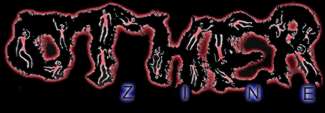
In Search Of The North American Direct Animator - Species and Variants
by Devon Damonte
Click here for printable version
Exploding from all corners are imagemakers embracing various permutations of handmade motion graphics. While most people with any knowledge of animation remember paint and scratch from the intro animation class, increasingly animators and experimental filmmakers are adopting this as a serious, unique genre of expressive artistic inquiry. Some add these techniques to their arsenal of image-making devices, combining them with traditional cel or computer animation, or experimental live action filmmaking. Others bounce back and forth between direct animation films and different styles. Then there are the few, the hardcore, the intractably obsessive practitioners who happily surrender to becoming completely consumed by the awesome potential for exploration in this field, an art form whose surface has barely been scratched (to flog a weary pun). This latter is my fraternal filmmaking order, and the species I seek.
For the history of this quirky, free-spirited breed, one generally starts with Len Lye (flying the uncompromising avant gardist flag) and Norman McLaren (representing the populist humanist institutionalized animator camp). Since the focus of this article is on current activity in the field, readers can learn the background elsewhere. Experimental Animation: Origins of a New Art (1976/88 De Capo) by Cecile Starr and Robert Russett is the best place to start. See also the Len Lye Foundation (don't miss Lye's remarkable writings), and Harry Smith Archives. For further details on artists discussed in this article, there's lots more text on all the following and more available by contacting me at my website - space limitations here offer a brief glance.
If I were taxonomically identified within this species, I might be 'obsessifus onetrackkia directcinezealotus,' commonly known the Pileated Stuckon Filmscratcher. I've been devoted to passionately creating and teaching "direct animation" (let's call it "DA" for short from here on) for fifteen years. Nearly two years ago I quit my job as a nonprofit arts administrator to take to the open road for DA watching / making / preaching full time. Here's what I found out there.

Rhode Island School of Design in Providence was the first sighting on my tour, when in September 2002 a world giant of DA, Baerbel Neubauer visited from Europe. Neubauer is a leader in the field, having burst onto the scene in the 90's with paint and scratch masterworks like Roots (1996), Moonlight (1997), and her powerful award-winning photogram masterpiece Firehouse (1998). She also collaborates with dancers and is currently working on digital applications for direct animation aesthetics.
After a brief spotting of my guru Cecile Starr (typically radiant in stunning white plumage) at her summering grounds in Burlington, VT, next stop was the 2002 Ottawa Int'l Animation Festival (OIAF). There, abstract motion graphics history was made with a new category for non-narrative film and an unprecedented quantity of DA works featured (full disclosure - my direct film Radio Active Spider was in the Panorama). These included serious, diverse works by heavy hitters Stephanie Maxwell (Rochester NY), Stephen Woloshen (Montreal - retrospective and in competition), and Richard Reeves (Calgary), plus a retrospective of hermetic mid-20th century handpainter Harry Smith. Even the OIAF welcome film was DA, with live 'projector orchestra' accompaniment.
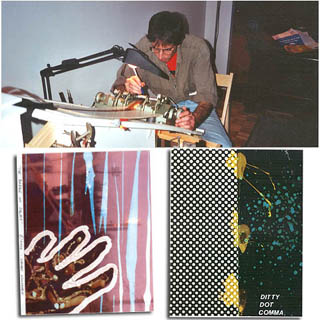 OIAF
flushed Montreal direct animator Stephen Woloshen from the thicket where
he has been actively, quietly making DA since the early 1980's. Woloshen
muses that "George Clooney and Warner Brothers produce my films but they
don't know it." That's because his day job is as a driver for big Hollywood
productions, and he makes his meticulously realized cameraless gems in
the downtimes in between. He says he often has conversations with bigtime
production people telling them about his films, and "they always describe
in vivid detail the DA projects they did in film school, remembering it
with great fondness as where they first discovered the thrill of cinema."
OIAF
flushed Montreal direct animator Stephen Woloshen from the thicket where
he has been actively, quietly making DA since the early 1980's. Woloshen
muses that "George Clooney and Warner Brothers produce my films but they
don't know it." That's because his day job is as a driver for big Hollywood
productions, and he makes his meticulously realized cameraless gems in
the downtimes in between. He says he often has conversations with bigtime
production people telling them about his films, and "they always describe
in vivid detail the DA projects they did in film school, remembering it
with great fondness as where they first discovered the thrill of cinema."
 No
DA cinemafari would be complete without visiting direct animation Mecca
- the Quickdraw Animation Society (QAS) in Calgary. Current QAS Film Production
Coordinator Richard Reeves' breathtaking Linear Dreams(1999) kicked up
many awards, plus attention for DA. Since then he's churned out more great
works with his signature vivid colors on black and intricate scratch soundtracks
including 1:1(2001) and Sea Song(2000). Meanwhile Reeves
continuously teaches across Canada and the US, most notably at Quickdraw's
annual "Cameraless Animation Extravaganza," a weeklong intensive workshop.
Nearly everybody at Quickdraw has made hardcore direct animated films,
including QAS co-honcho Carol Beecher's Ask Me, and member Don
Best's Spare Change.
No
DA cinemafari would be complete without visiting direct animation Mecca
- the Quickdraw Animation Society (QAS) in Calgary. Current QAS Film Production
Coordinator Richard Reeves' breathtaking Linear Dreams(1999) kicked up
many awards, plus attention for DA. Since then he's churned out more great
works with his signature vivid colors on black and intricate scratch soundtracks
including 1:1(2001) and Sea Song(2000). Meanwhile Reeves
continuously teaches across Canada and the US, most notably at Quickdraw's
annual "Cameraless Animation Extravaganza," a weeklong intensive workshop.
Nearly everybody at Quickdraw has made hardcore direct animated films,
including QAS co-honcho Carol Beecher's Ask Me, and member Don
Best's Spare Change.
Closer to my vagabond homes, Crackpot Crafters is a free weekly workgroup of handmade filmmaking I organized in early spring 2002. It's an informal ragtag assembly likened to a "quilting bee for film freaks" sharing techniques and gossip, usually in artists' live-work/ lofts. Inspired by SF's Thad Povey and the Scratch Film Junkies, and Brakhage's weekly gatherings, Crafters began in South Boston and so far has alighted in Providence/Olneyville, RI, Waltham, MA, Seattle and Olympia.
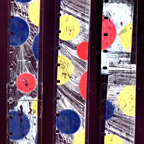 While
in Austin, Texas to screen my recent DA film WonderPain at SXSW, veteran
LA animator Gary Schwartz was coincidentally teaching a DA workshop down
the street. Gary features DA as a key component of his workshops, and
when asked about the particular, spunky, good humored spirit of direct
animators he comments "there's no question about it - all people involved
in any kind of animation, we're all into the things that don't make any
sense. Things, for example, like 3D stereo slides, or wooden boat building.
We love all the same things - the things that are beautiful and soulful,
and have all the qualities that are missing from modern efficiencies."
While
in Austin, Texas to screen my recent DA film WonderPain at SXSW, veteran
LA animator Gary Schwartz was coincidentally teaching a DA workshop down
the street. Gary features DA as a key component of his workshops, and
when asked about the particular, spunky, good humored spirit of direct
animators he comments "there's no question about it - all people involved
in any kind of animation, we're all into the things that don't make any
sense. Things, for example, like 3D stereo slides, or wooden boat building.
We love all the same things - the things that are beautiful and soulful,
and have all the qualities that are missing from modern efficiencies."
 Continuing
along the southern migratory route, Helen Hill in New Orleans is forever
famous for publishing "Recipes for Disaster:
A Handcrafted Film Cookbooklet" in which 40 filmmakers offer secrets
for cheap handmade moviemaking. Helen also makes wonderful animation,
including the how-to cameraless primer Madame Winger Makes a Film:
A Survival Guide to the 21st Century (2001). While in the Big Easy,
my roadshow screened on a double bill with overlooked New Yorker Donna
Cameron's "paper emulsion" films. It turns out this woman has been cranking
out forms of DA for 30 years, and in fact now holds US Patent #6,232,033
for her unique process involving photographs and adhesives and rubbing,
and if you knew any more I'd have to kill you. Cameron's many films including
World Trade Alphabet (2001) are diverse in styles but all share
passionate emotion and the grit of being human in modern times.
Continuing
along the southern migratory route, Helen Hill in New Orleans is forever
famous for publishing "Recipes for Disaster:
A Handcrafted Film Cookbooklet" in which 40 filmmakers offer secrets
for cheap handmade moviemaking. Helen also makes wonderful animation,
including the how-to cameraless primer Madame Winger Makes a Film:
A Survival Guide to the 21st Century (2001). While in the Big Easy,
my roadshow screened on a double bill with overlooked New Yorker Donna
Cameron's "paper emulsion" films. It turns out this woman has been cranking
out forms of DA for 30 years, and in fact now holds US Patent #6,232,033
for her unique process involving photographs and adhesives and rubbing,
and if you knew any more I'd have to kill you. Cameron's many films including
World Trade Alphabet (2001) are diverse in styles but all share
passionate emotion and the grit of being human in modern times.
NY is also home to the dynamic duo of DA, Sandra Gibson and Luis Recoder. Sandra rapidly established her reputation as a DA force with Edgeways (1999) made at Rhode Island School of Design. In numerous residencies since, she's made a staggering quantity of films using various direct techniques and optical printing. In 2000 at the Rotterdam fest Gibson hooked up with avant garde wunderkid Luis Recoder. The tall twosome occasionally collaborate but more often offer their individual works as a double barrel blast of top shelf direct film experience. At our NY expansion of my roadshow, Gibson showed Ribbon (2002) made of typewriter ribbon, accompanied by live typed sound and screened with the projector sideways, while Recoder offered Needles (2002), a delicate and majestic scratch sound structure piece.
Galvanizing the fledglings, for the past 5 summers, Xander Marro organized Movies With Live Soundtrax bimonthly events in Providence, Rhode Island. Each night in a different location roughly a dozen filmmakers presented new work, usually created expressly for that single screening, and accompanied by live performance ranging from a fifteen piece orchestra, to a single guitar, to a talking toy pony. DA techniques figured prominently in these shows since the immediate projectability ideally suits this DIY punk-rockish spirit.
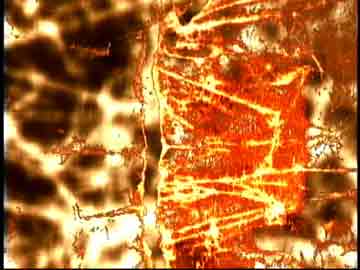 In
Rochester, NY, where one might wonder how a little DA birdie could survive
the winters Stephanie Maxwell has been a major force in DA for the past
decade. Through her prolific output of rigorous personal work including
recent gems terra incognita (2001) and past favorites Outermost
(1998), plus her teaching at Rochester Institute of Technology, she
continues to make her mark. Perhaps the most exciting and prophetic aspect
about Maxwell's work for the DA field is that she completes all her works
digitally. Her process starts on strips of 35mm which are then shot, manipulated
and edited in video for presentation. Maxwell also shares the generosity
of spirit (and technique) combined with inspirational magical pixie sparkle
common among so many serious direct animators.
In
Rochester, NY, where one might wonder how a little DA birdie could survive
the winters Stephanie Maxwell has been a major force in DA for the past
decade. Through her prolific output of rigorous personal work including
recent gems terra incognita (2001) and past favorites Outermost
(1998), plus her teaching at Rochester Institute of Technology, she
continues to make her mark. Perhaps the most exciting and prophetic aspect
about Maxwell's work for the DA field is that she completes all her works
digitally. Her process starts on strips of 35mm which are then shot, manipulated
and edited in video for presentation. Maxwell also shares the generosity
of spirit (and technique) combined with inspirational magical pixie sparkle
common among so many serious direct animators.
On the 'institutional' end, there is even a center dedicated to DA watchers and all forms of visual music. The iotaCenter in Los Angeles, with guidance from scholars like William Moritz, has circulated four kickass touring programs of historical and current experimental animation, and has an extensive archive of related materials. Director Cindy Keefer says "iotaCenter is ALWAYS interested in seeing and receiving screeners of new direct animation for our Study Center, for access by researchers and for our own screenings.
To further brighten the DA revolution horizon, the current queen ruling the roost of animation journalism Maureen Furniss is deep in production with a magnificent book on experimental animation techniques and history which includes a thick juicy chapter on DA (including its avant-garde cinema practitioners). Though the book isn't due out until 2005 or so (to be published by Lawrence King in London with US distribution), my sources guarantee it will be worth the wait. This book seems destined to carry the torch lit by Starr and Russett's seminal primer, inspiring another generation of experimentalists toward DA and beyond.
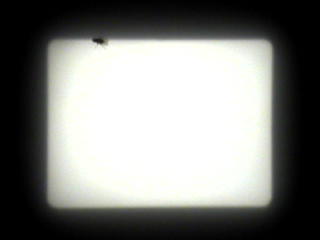 Luis
Recoder resists the DA term for his work, but comments, "'Cameraless Animation'
is a composite term - an aggregate of a negative and a positive. 'Camera-less'
designates the negative in its negation of the/a technical device called
The Camera, whereas 'Animation' is the positive term imbued with its own
livelihood, a joy even. So that 'Cameraless Animation' stands for the
promise of a negative that will be reversed, overcome, and transcended
by thoroughly animating it through none other than direct techniques of
animation. As if 'fun' could be had in the rehabilitation of a fullness,
a plenitude in an era of profound negativity, absence, lack, void?! This
would certainly make us all happy consciousness'.
Luis
Recoder resists the DA term for his work, but comments, "'Cameraless Animation'
is a composite term - an aggregate of a negative and a positive. 'Camera-less'
designates the negative in its negation of the/a technical device called
The Camera, whereas 'Animation' is the positive term imbued with its own
livelihood, a joy even. So that 'Cameraless Animation' stands for the
promise of a negative that will be reversed, overcome, and transcended
by thoroughly animating it through none other than direct techniques of
animation. As if 'fun' could be had in the rehabilitation of a fullness,
a plenitude in an era of profound negativity, absence, lack, void?! This
would certainly make us all happy consciousness'.
The DA Revolution is Now. Join the flock. We've been expecting you!